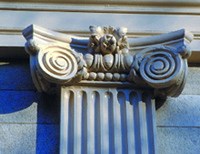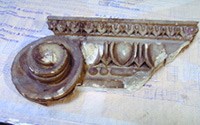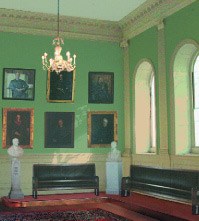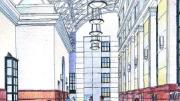Biology has entered an era in which life's deepest mysteries appear at least knowable, if still undeciphered. The mapping of the human genome and the genomes of other organisms, such as the fruit fly and the roundworm, has opened a new realm of inquiry in the life sciences. But genomics, as this branch of biology is often called, demands the expertise of scientists across many disciplines. Harvard's genomics effort, an interdepartmental initiative launched by Faculty of Arts and Sciences dean Jeremy R. Knowles in 1999, will by 2002 be housed in a state-of-the-art facility, the Bauer Life Sciences Building. The new, 60,000-square-foot structure, designed by architects Ellenzwieg Associates, will link the recently completed Naito Chemistry Laboratory, still gleaming, to the Fairchild Biochemistry Building, a physical manifestation of the cross-departmental linkages and collaborations that will occur there.
The building, which will house the Bauer Center for Genomic Research, is named for Charles T. "Ted" Bauer '42, who has given $25 million, one of the largest gifts in the University's history, to support the life sciences in general and genomics in particular. Bauer is cofounder of Houston-based AIM Management Group, one of the nation's largest and most successful mutual-fund companies. During the University Campaign, he helped set up the financial-aid challenge fund, which inspired alumni contributions of $230 million for undergraduate financial aid.
What excites Bauer about the genomics center is not only the new knowledge it will produce, but the way that it will do it. "What really fascinates me is how they are going to run the center with the smartest young minds from every discipline working there together," he says. "I've always thought, in my business, that the best way to do things is to get the most creative thinkers you can, throw them into a problem headfirst, and let them go. I can tell you from experience that it works."
The center will recruit physicists, mathematicians, chemists, engineers, and computer scientists to work together on three major challenges at the frontiers of scientific knowledge, says its director, professor of biology Andrew W. Murray. First, the Bauer endowment will "enable us to understand how cells work in all their diversity and complexity. Second, it's going to make an extraordinary contribution to how we think about evolution by telling us how we got here. And third, we can use genome-wide approaches to devise new methods of pinpointing the molecular defects that cause human diseases." The gift will also fund a new experimental and theoretical genomics course for undergraduates.
Meanwhile, as excavation for the Bauer Building began, two other projects were approaching completion nearby in Harvard Yard. At Widener Library, the major structural work involved in creating two new reading rooms has ended. No longer needed, the great yellow crane whose boom swept silently to and fro across the Cambridge skyline (see "John Harvard's Journal," September-October 1999, page 67) was taken down over Thanksgiving weekend. Not a moment too soon, apparently: In the dead of night, over the Head of the Charles weekend, someone of considerable athleticism climbed the tower, scaled the smooth exterior of the locked control cab that provides access to the boom, and nicked the Harvard College Library flag that flew there.
A stone's throw away, the renovation of University Hall, which has been fitted with a new heating, ventilating, and air conditioning system (see "Hallowed, Harrowed University Hall," May-June 1999, page 71), proceeded quickly. "The sparkling granite of Bulfinch's splendid masterpiece in the Yard is now clean, the more subtle original color of the pilasters and windows has been restored, and all those horrible window air-conditioners have gone," says Dean Knowles, with evident satisfaction. "University Hall has not looked so good since its last renovation, in 1896! Inside, many ugly additions--of sprinklers, lights, pipes, and wires--have been hidden, and the Faculty Room will be brought closer to its first and more stylish incarnation."
 |  |
| The capitals atop the exterior pilasters of Charles Bulfinch's University Hall (above) are believed to be original. They likely served as models for the capitals (and pilasters) restored to the Faculty Room in 1896 (right), which had long since been removed. During the renovations of 2000, a large fragment of a capital (above, right) was found in a wall of the building. This design is thought to be the one dating to Bulfinch's day, when the room served as the chapel. | Photographs by Jim Harrison |
 | A computer pastiche of the Faculty Room shows how the space will look come January, with the 1896 tan-and-green color scheme. |
| Brad Koerner |
Knowles also announced at the November faculty meeting that a portrait of Cecilia Payne-Gaposchkin, "the first woman to gain a Ph.D. in astronomy at Harvard and the first woman to receive tenure in the Faculty of Arts and Sciences," would grace the restored Faculty Room sometime next year. Payne-Gaposchkin's portrait will join that of Helen Maud Cam, whom Knowles, quoting Cam herself, called a "first swallow of spring" when that first portrait of a woman was hung in the Faculty Room in 1995 (see May-June 1995, page 62). The commission was made possible by the generosity of faculty members Dudley and Georgene Herschbach.







